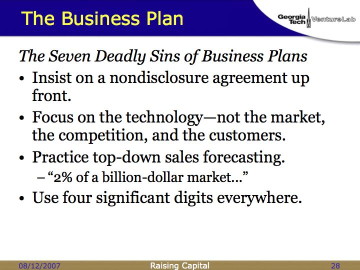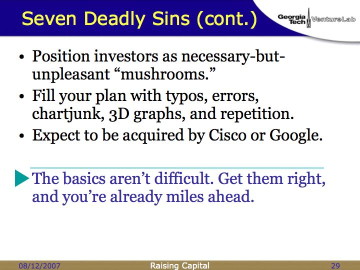This is a continuation of a previous set of posts and is ninth in a series.
So it’s always nice to talk about “Seven Deadly Sins”… there are probably more when it comes to business plans, but these are pretty basic.
Yes, I have seen plans that commit all seven!
1) Insist on a non-disclosure agreement up front.
Venture capitalists don’t sign NDAs. At this point (2008), neither will many angel investors. Get over it. If the first page behind your cover page is an NDA, most investors will close the cover and toss the document in the trash. (If you’re into saving trees and don’t actually print your business plan, that’s fine. Update metaphor accordingly.)
Why? Brad Feld gives as good a summary as I have ever seen, and further quotes Guy Kawasaki:
Before you even start addressing the hard stuff, never ask a venture capitalist to sign a non-disclosure agreement (NDA). They never do. This is because at any given moment, they are looking at three or four similar deals. They’re not about to create legal issues because they sign a NDA and then fund another, similar company—thereby making the paranoid entrepreneur believe the venture capitalist stole his idea. If you even ask them to sign one, you might as well tattoo “I’m clueless!” on your forehead.
2) Focus on the technology—not the market, the competition, and the customers.
This one is common. Founders of startups tend to be passionate about their technology, and that passion leaks out all over. Including into their business plans.
As I said last month…
Cut out almost everything related to your neato-keen technology. Out of the twenty pages, you can have two on technology. Not three. Two. Because I want you to spend the remaining sixteen pages (two more got chewed up by the executive summary, remember?) talking about your team, your company history, your customers (if any), your revenue (if any), your competitors (you definitely have some), your channel strategy, your potential acquirors… you know, all that stuff that might actually make me want to invest in your company!
There will be plenty of time to talk about your technology later. For now, I just need enough of a taste to get hooked.
3) Practice top-down sales forecasting.
Again, an amateur mistake. It’s a red flag when I see “The market is a billion dollars a year, so all we need is 2% and we’re a $20M/year company.” Bzzzt. Wrong!
Not because the math is wrong (it’s not). But because mature markets tend to shake out into a 50% player, an 30% player, a 15% player, and a bunch of losers. If you’re targeting 2% share, you’re saying “I want to be a loser!”
(Or you want to be Apple. Great; I respect that. But I probably wouldn’t invest in it as a startup strategy today.)
That’s top-down sales forecasting, and it’s useless. Professionals do bottoms-up sales forecasting: Example:
“Our average sales cycle is XX days. We have XX sales professionals on board now, and are hiring XX over the next quarter. The new ones will take XX weeks to come fully online. At steady state, each salesperson can handle XX accounts simultaneously while chasing XX prospects. Our conversion rate from prospects to sales is XX% per month. This translates into a sell rate of XX widgets per month starting in Q4. Average selling price will be reduced to $X to allow for anticipated competition, so Q4 sales are anticipated to be $XX0,000.”
Okay, now you have my attention. We may disagree on the assumptions, and we can have interesting fights over sensitivity analysis, but at least I know I’m not dealing with an amateur.
Note that you will back into a market share calculation here that actually has meaning, rather than sticking your fingers into the wind and making a wild guess. If your share isn’t 15% or better, perhaps you need to re-scope your market—not “share of wiki sites,” but “share of SaaS wiki sites hosted for SMBs.” Does it still sound interesting? Compelling?
4) Use four significant digits everywhere.
I touched this one in passing two paragraphs back. If you say your sales forecasts for the fourth quarter are $320,000, then I may be happy or sad about that number, but at least you’re not advertising that you’re an idiot. If you say your forecasts are $321,783.45″, then I know you’re an idiot. I don’t invest in idiots.
Don’t just regurgitate numbers because Excel calculated them for you. Excel has a ROUND() function. Use it, early and often, and establish reasonable error bars on your forecasts. Two significant figures everywhere is about right. Three should be backed up by some historical experience. Four or more is silly.
(This is about the only place where I miss slide rules. Yes, I had one. No, you couldn’t get arbitrary precision out of it… you had to learn to live with two significant figures, plus a third which you estimated and which was frankly questionable. False precision is another red flag for sloppy thought processes.)
5) Position investors as necessary-but-unpleasant “mushrooms.”
You know how to raise mushrooms: keep them in the dark and feed them plenty of… um, manure. Investors hate that. If you’re smart enough to run the company without any advice from anybody, I hope you’re rich enough to run it without any money from anybody, too.
Every VC claims to be “value-added.” A pleasingly-high percentage actually are. When you do your diligence on the firm (yes, you should do diligence on them, just like they are going to do diligence on you!), figure out which is which… and you should only be targeting the ones that really do add value to your company. Once you’ve picked value-added investors, let add value! Bring them in to your thought processes and decision-making!
Otherwise, you run the risk of surprising them. Investors hate surprises. (Even good ones.)(Really!)
6) Fill your plan with typos, errors, chartjunk, 3D graphs, and repetition.
I touched on this in the previous post but let me emphasize it here. If you make mistakes in your plan, I’m going to assume that you are stupid, sloppy, lazy, or incapable of getting help. None of these make me want to invest in you as an entrepreneur. For “chartjunk,” see Tufte.
Reminder:
Edward Tufte is in town tomorrow and Tuesday (24-25 March 2008). If you’re in Atlanta, you should go.
And, for crying out loud, if you’re not displaying three dimensions of information, don’t use a three-dimensional chart. The only reason to use the 3D charts in Excel are to intentionally obscure< /a> your data and try to hide something you’re not happy about. Red flag!
As Jorge Aranda says, “Excel must be the most powerful enabler of graphic disasters in the world. Most people don’t have the time, or the dedication, or the skill, to improve Excel’s default graphic settings.” Set yourself apart: Learn. Or hire someone who knows already.
(As you might expect, the graphics defaults for Apple Numbers, their spreadsheet package, are infinitely more attractive than for Excel. But the principle remains… if you’re just prettying up the numbers, stop. Is this really what you want to be doing in a business plan?)
7) Expect to be acquired by Cisco or Google.
This slide used to say “Microsoft,” but the boys in Redmond have had a rough decade (and their proposed acquisition of Yahoo is just sad). Google and Cisco are still hanging in there, and continually building value by acquiring bright young startup teams. But there’s a limit to how many companies Google and Cisco can buy, and there are a lot of great startups out there… more than that limit.
Don’t set your focus so narrowly that there are only one or two or a handful of potential acquirors. Build enough value that lots of companies will want to assimilate your team, your customers, your product, and you (probably in that order). That’s what leads to bidding wars. Cha-ching!
Repeating a comment to my previous post—if I’d seen this earlier, I’d have linked to it more visibly:
http://www.scottburkett.com/index.php/atlanta-business-scene/2008-02-16/having-fun-down-at-tech.html
Good advice there from another member of Haynie’s Atlanta Startup Posse.

